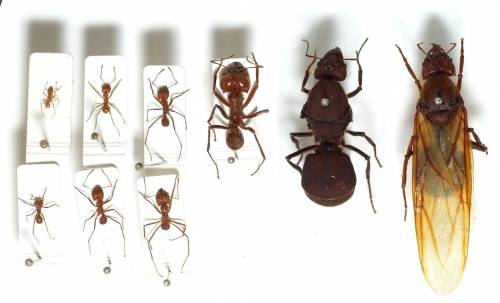Ant Research
Ant Research - Sciences, Education, Art, Writing, UFO - Posted: 22nd Jan, 2017 - 8:23pm
Ant Research
Nine to 20 Individual Fire Ant Queens Started U.S. Fire Ant Population
By Sharon Durham
July 30, 2008
The current U.S. Population of red imported fire ants--which infest millions of acres across the southern states--can be traced back to nine to 20 queens in Mobile, Ala.
That's according to a genetic study by Agricultural Research Service (ARS) entomologist D. DeWayne Shoemaker and University of Georgia entomologist Kenneth G. Ross. The results are reported in the Proceedings of the Royal Society, Biological Sciences.
The red imported fire ant (Solenopsis invicta), native to South America, is a major invasive pest insect and is considered by the World Conservation Unit to be among the top 100 worst invasive alien species.
In their study, the scientists found that those original nine to 20 queens stowed away on a boat, presumably each with their worker force, and began populating the United States in the mid-1930s. These ants spread outward from the purported initial landing spot in Mobile.
Pinpointing the number of queens needed to account for the genetic diversity in the current population allows researchers to better develop biologically-based management practices, predict the invasive potential of the species, and make inferences about the ecological and evolutionary processes.
Because of the red imported fire ant's status as a major pest, an enormous amount of research has been conducted on the basic biology of the species over the past 40 years, making it one of the better known invasive organisms.
Individuals from two populations in South America and six populations across the southern United States were collected for genetic analysis. Data collected substantiates the theory that there is a close genetic resemblance of ants collected near Mobile to a hypothetical, reconstructed ancestral population. However, the data also raises the possibility of a secondary introduction at a location 60 miles west of Mobile.
Further genetic analysis will improve knowledge of the reproductive biology, population demographics, genetics and invasive history of red imported fire ants which may assist in controlling them.
ARS is a scientific research agency of the U.S. Department of Agriculture.
Source: USDA Agricultural Research Service
Image from Wikimedia public domain.

Ant Research (Hover)
Research Ant
Ants find their way even when going backwards
Ants can get their bearings whatever the orientation of their body, new research shows. Their brains may be smaller than the head of a pin, but ants are excellent navigators that use celestial and terrestrial cues to memorize their paths. To do so, they use several regions of the brain simultaneously, proving once again that the brain of insects is more complex than thought. Ref. Source 8z.
 TOPIC: Ant Research
TOPIC: Ant Research